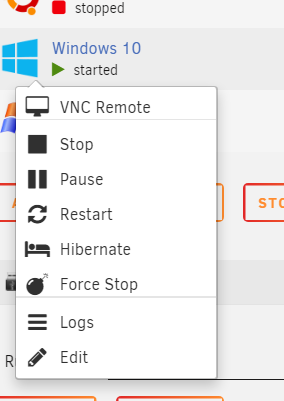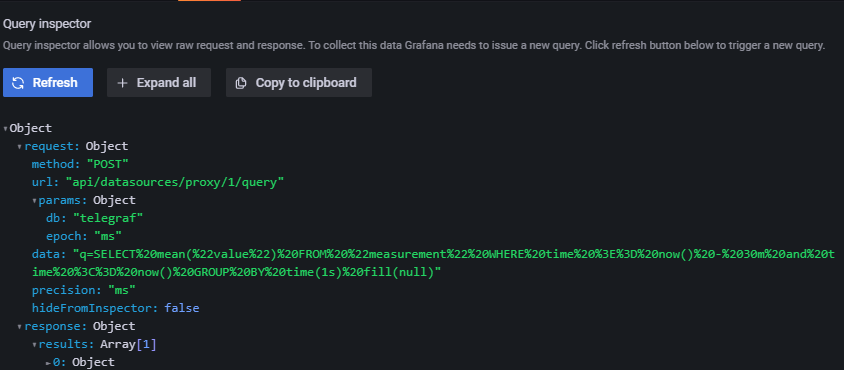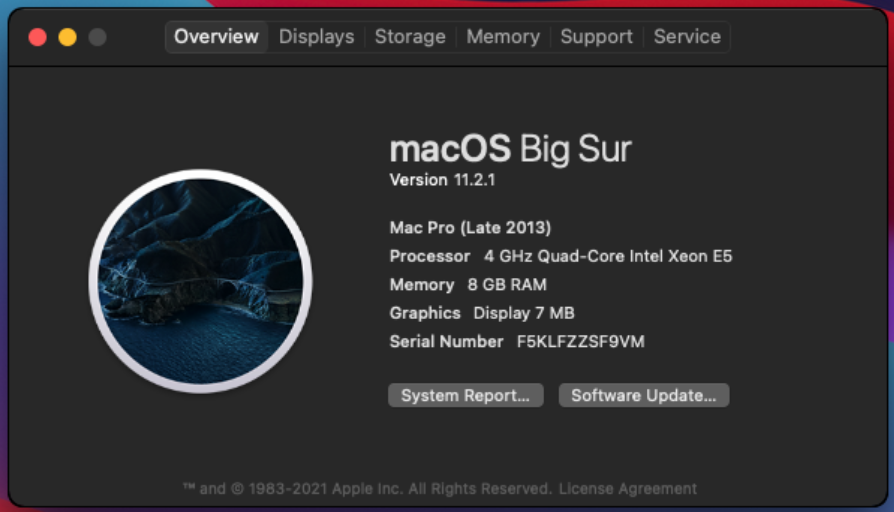
stelks
-
Posts
26 -
Joined
-
Last visited
Content Type
Profiles
Forums
Downloads
Store
Gallery
Bug Reports
Documentation
Landing
Posts posted by stelks
-
-
Has anyone been able to get SQLite Database working as described in the 4.4.0 changenotes? It is supposed to improve performance when running 1k+ torrents.
n 4.4.0 there was a new setting added:EXPERIMENTAL: Setting to store/load fastresume/torrent files in an SQLite database (glassez)
-
Hi Everyone,
I am running into an issue where I need to instances of this container. I am at about 2500 torrents and the UI is slow as all hell. What I would like to do is more less create a 1:1 copy with all the same torrents in the new instance. I have everything labeled so I will just be able to go in and remove about 2300 torrents that I dont need to manage from the original instance and then just have them in the new instance. Obviously I would pause everything before I do this to make sure I am not double seeding while I am making the changes.
Ive quickly tried this out by creating a new container with my old one as a template and incrementing all of the ports up by one. Well that did not work as it was just pulling the info from the old directory and not creating a separate folder. Can anyone help me on the correct way to do this?Thanks!
-
Anyone have issues with slowness in this container. For example when sorting by different settings like upload/download speed or date added it takes a while for it to update ~3-8 seconds. This is kinda for anything in the container, even switching to that tab in chrome and waiting for it to update.
For reference:
Server: 20c/40t 128GB RAM nothing dedicated - added like a standard container
Seeding ~1000 torrents
AppData is running on a SSD
Is this common? And if it is is there any way to speed this up?
-
Relatively simple feature. I would like the ability to clone a VM when its off. This would be done off of the click menu:

Lot of use cases for this and easier to implement then snapshots. Sometimes I want to test things in VM's and want to just be able to make a copy to then have in case I want to revert. Also useful for having a baseline image that is already configured to easy prop up a VM without doing the whole install. Recently I wanted to try Windows 11. Would have been nice to simply be able to duplicate my Win10 VM and upgrade that, then have both available to me to choose from.
-
 4
4
-
 6
6
-
-
This would be neat to do, I see there is official builds for RHEL and unofficial for Ubuntu. Just wondering if anyone has had success with this.
-
 1
1
-
-
Hey Guys, Just looking for some advice here as I am migrating my unRAID server from consumer hardware to used enterprise and have a few questions for those who are more knowledgeable then me.
Current system: i7 4790k 32GB Ram
New system: Dell R530 2x E5-2660 v3 (20 cores 40 with HT) 128GB RAM (8x 16GB 2133)
Firstly, The new system comes with 8 1.2TB 10k SAS drives. I currently have 4 14TB SATA drives. From what I have seen it looks like I can use both types of drives at once as long as they are not in the same array which is not an issue with unRAID. Would it be possible to have the 4 SATA drives set up in unRAID for my storage array then use the SAS drives for a secondary cache pool (I have a SSD I use for my cache pool now that I figure ill buy a low-profile PCIE card to connect that)?
Also I have a GTX950 that I use now for Plex in transcoding. The server does not have any full height PCIE slots but it looks like I can just slap this in it: https://www.ebay.com/itm/185088641357?hash=item2b1824894d:g:8PsAAOSwQr9hW5wZ
Is my assumption correct?
Anything else I should be considering here?
Thanks!
-
-
5 minutes ago, ich777 said:
Apparently not because it doesn't work. 😅
Discovering the root cause is half the battle

-
32 minutes ago, ich777 said:
Can you go to the none working dashboard, hover over the titlec frome one graph, click the little down arrow, then Edit, then a new windows should pop up, click on Query inspector and click on Refresh from the sidebar that pops up and see if you got any data in the graph, if you don't have the Edit button from the dropdown you have to make the Dashboard editable by clicking on the little gear icon on top and click make editable and go back to the dashboard again.
Are you also tried that you've restarted Grafana once?
The data should be there imediately.
So I think I found the issue. After following your directions the Query inspector gives me the following:

But then I noticed that it is trying to pull from Telegraf:

I can change that to Prometheus and nothing happens still. I have deleted the dashboard a few times and dont see a place to enter what data source to pull from globally for the dashboard.
Any idea why it is selecting Telegraf instead of Prometheus for all of these?
Thanks again. You have been a big help
-
27 minutes ago, ich777 said:
Can you go to Prometheus and click on the URL from your PiHole Exporter? Do you get any output?
Eventually try to delete and reimport the Dashbaord again.
Here is what I get if I go to Prometheus and click the URL from the Exporter:
I can tell its working as the numbers are right:
I just deleted the dashboard and reimported it again. Still saying no data, but Ill give it some time again as you said before it can take a bit.
-
16 hours ago, ich777 said:
Please give it a little time to pick up the data and make sure the exporter is running in the plugin page.
PiHole can take a little to update if you configured it for the first time.
I gave it overnight and still no dice. It looks like its not getting any data to Grafana at all even though I can see that the plugin is working fine
-
2 hours ago, ich777 said:
You have set the IP wrong in the prometheus.yml you have to specify the unRAID IP not the PiHole IP.
The PiHole Exporter is a bridge between your PiHole and Prometheus that runs on unRAID.
Thank you for your help that got it working in Prometheus!(Could of sworn I tried both lol)
Do you have any idea why it would not be pulling the data into Grafana now that that is configured correctly. All of my other dashboards in Grafana that use Prometheus work fine but the piHole one just says no data. I have restarted all of the containers and deleted and re-imported the template.
-
-
Hoping you guys could help me with this issue I am having. Recently whenever I watch a video that comes from a large file my entire server locks up after a little bit and I have to restart the Plex container. What I have come to notice is that basically Plex is filling my ram with whatever the file is I am watching as I am watching. For example if I am watching a 40GB BluRay movie that is 90 minutes, after 90 minutes my Plex container will be using 40GB, issue is I only have 32GB of ram in my server and I cant even give it all of that amount. When I stop watching the movie the ram is given back.
Some notes that might help: DLNA is off Everything is generally direct play (exception of audio transcoding) I have updated to the newest verion of PMS When I stop watching the video all of the memory is given back.
This is after watching Top Gun for 30 minutes:

Here is the config if that helps:
Let me know if I can pull any other logs that would help with this
Any help is appreciated.
-
I have a container that needs to be routed though a VPN with a dedicated IP (I use private internet access). Anyone have ideas on how I can accomplish this?
I currently do have a binhex-delugevpn container running that uses the same VPN but I can not figure out how to make it work with the dedicated IP. I know if I could get that working I can route this other container though the Duluge container and then it would work.
Reasoning for doing this is I have a service I want to access outside of my home and due to having community wifi I am stuck with a double-nat situation and this seems like the best way to resolve it.
Any help is appreciated.
Thanks
-
If someone could take a look at my XML it would be super helpful. I can not get my VM to sign into Apple Services. I have changed the network adaptor and tried a couple different configs.
<?xml version='1.0' encoding='UTF-8'?> <domain type='kvm' id='23' xmlns:qemu='http://libvirt.org/schemas/domain/qemu/1.0'> <name>Macinabox BigSur</name> <uuid>88b75df0-9fdb-435d-b07f-f8d5ac24775f</uuid> <description>MacOS Big Sur</description> <metadata> <vmtemplate xmlns="unraid" name="Windows 10" icon="BigSur.png" os="osx"/> </metadata> <memory unit='KiB'>8388608</memory> <currentMemory unit='KiB'>8388608</currentMemory> <memoryBacking> <nosharepages/> </memoryBacking> <vcpu placement='static'>8</vcpu> <cputune> <vcpupin vcpu='0' cpuset='0'/> <vcpupin vcpu='1' cpuset='4'/> <vcpupin vcpu='2' cpuset='1'/> <vcpupin vcpu='3' cpuset='5'/> <vcpupin vcpu='4' cpuset='2'/> <vcpupin vcpu='5' cpuset='6'/> <vcpupin vcpu='6' cpuset='3'/> <vcpupin vcpu='7' cpuset='7'/> </cputune> <resource> <partition>/machine</partition> </resource> <os> <type arch='x86_64' machine='pc-q35-4.2'>hvm</type> <loader readonly='yes' type='pflash'>/mnt/user/system/custom_ovmf/Macinabox_CODE-pure-efi.fd</loader> <nvram>/etc/libvirt/qemu/nvram/88b75df0-9fdb-435d-b07f-f8d5ac24775f_VARS-pure-efi.fd</nvram> </os> <features> <acpi/> <apic/> </features> <cpu mode='host-passthrough' check='none' migratable='on'> <topology sockets='1' dies='1' cores='4' threads='2'/> <cache mode='passthrough'/> </cpu> <clock offset='utc'> <timer name='rtc' tickpolicy='catchup'/> <timer name='pit' tickpolicy='delay'/> <timer name='hpet' present='no'/> </clock> <on_poweroff>destroy</on_poweroff> <on_reboot>restart</on_reboot> <on_crash>restart</on_crash> <devices> <emulator>/usr/local/sbin/qemu</emulator> <disk type='file' device='disk'> <driver name='qemu' type='raw' cache='writeback'/> <source file='/mnt/user/domains/Macinabox BigSur/macos_disk.img' index='1'/> <backingStore/> <target dev='hdc' bus='sata'/> <boot order='1'/> <alias name='sata0-0-2'/> <address type='drive' controller='0' bus='0' target='0' unit='2'/> </disk> <controller type='usb' index='0' model='ich9-ehci1'> <alias name='usb'/> <address type='pci' domain='0x0000' bus='0x00' slot='0x07' function='0x7'/> </controller> <controller type='usb' index='0' model='ich9-uhci1'> <alias name='usb'/> <master startport='0'/> <address type='pci' domain='0x0000' bus='0x00' slot='0x07' function='0x0' multifunction='on'/> </controller> <controller type='usb' index='0' model='ich9-uhci2'> <alias name='usb'/> <master startport='2'/> <address type='pci' domain='0x0000' bus='0x00' slot='0x07' function='0x1'/> </controller> <controller type='usb' index='0' model='ich9-uhci3'> <alias name='usb'/> <master startport='4'/> <address type='pci' domain='0x0000' bus='0x00' slot='0x07' function='0x2'/> </controller> <controller type='pci' index='0' model='pcie-root'> <alias name='pcie.0'/> </controller> <controller type='pci' index='1' model='pcie-root-port'> <model name='pcie-root-port'/> <target chassis='1' port='0x10'/> <alias name='pci.1'/> <address type='pci' domain='0x0000' bus='0x00' slot='0x02' function='0x0' multifunction='on'/> </controller> <controller type='pci' index='2' model='pcie-root-port'> <model name='pcie-root-port'/> <target chassis='2' port='0x11'/> <alias name='pci.2'/> <address type='pci' domain='0x0000' bus='0x00' slot='0x02' function='0x1'/> </controller> <controller type='pci' index='3' model='pcie-root-port'> <model name='pcie-root-port'/> <target chassis='3' port='0x12'/> <alias name='pci.3'/> <address type='pci' domain='0x0000' bus='0x00' slot='0x02' function='0x2'/> </controller> <controller type='pci' index='4' model='pcie-root-port'> <model name='pcie-root-port'/> <target chassis='4' port='0x13'/> <alias name='pci.4'/> <address type='pci' domain='0x0000' bus='0x00' slot='0x02' function='0x3'/> </controller> <controller type='virtio-serial' index='0'> <alias name='virtio-serial0'/> <address type='pci' domain='0x0000' bus='0x02' slot='0x00' function='0x0'/> </controller> <controller type='sata' index='0'> <alias name='ide'/> <address type='pci' domain='0x0000' bus='0x00' slot='0x1f' function='0x2'/> </controller> <interface type='bridge'> <mac address='52:54:00:9e:76:8a'/> <source bridge='br0'/> <target dev='vnet0'/> <model type='e1000-82545em'/> <alias name='net0'/> <address type='pci' domain='0x0000' bus='0x01' slot='0x00' function='0x0'/> </interface> <serial type='pty'> <source path='/dev/pts/0'/> <target type='isa-serial' port='0'> <model name='isa-serial'/> </target> <alias name='serial0'/> </serial> <console type='pty' tty='/dev/pts/0'> <source path='/dev/pts/0'/> <target type='serial' port='0'/> <alias name='serial0'/> </console> <channel type='unix'> <source mode='bind' path='/var/lib/libvirt/qemu/channel/target/domain-23-Macinabox BigSur/org.qemu.guest_agent.0'/> <target type='virtio' name='org.qemu.guest_agent.0' state='connected'/> <alias name='channel0'/> <address type='virtio-serial' controller='0' bus='0' port='1'/> </channel> <input type='tablet' bus='usb'> <alias name='input0'/> <address type='usb' bus='0' port='1'/> </input> <input type='mouse' bus='ps2'> <alias name='input1'/> </input> <input type='keyboard' bus='ps2'> <alias name='input2'/> </input> <graphics type='vnc' port='5900' autoport='yes' websocket='5700' listen='0.0.0.0' keymap='en-us'> <listen type='address' address='0.0.0.0'/> </graphics> <video> <model type='qxl' ram='65536' vram='65536' vgamem='16384' heads='1' primary='yes'/> <alias name='video0'/> <address type='pci' domain='0x0000' bus='0x00' slot='0x01' function='0x0'/> </video> <memballoon model='virtio'> <alias name='balloon0'/> <address type='pci' domain='0x0000' bus='0x03' slot='0x00' function='0x0'/> </memballoon> </devices> <seclabel type='dynamic' model='dac' relabel='yes'> <label>+0:+100</label> <imagelabel>+0:+100</imagelabel> </seclabel> <qemu:commandline> <qemu:arg value='-usb'/> <qemu:arg value='-device'/> <qemu:arg value='usb-kbd,bus=usb-bus.0'/> <qemu:arg value='-device'/> <qemu:arg value='isa-applesmc,osk=xxxxxxxxxxxxxxxxxxxxxxxxxxxxxx'/> <qemu:arg value='-smbios'/> <qemu:arg value='type=2'/> <qemu:arg value='-cpu'/> <qemu:arg value='Penryn,kvm=on,vendor=GenuineIntel,+invtsc,vmware-cpuid-freq=on,+pcid,+ssse3,+sse4.2,+popcnt,+avx,+aes,+xsave,+xsaveopt,check'/> </qemu:commandline> </domain>

-
Just now, jonathanm said:
No, with 2 drives in RAID1, the space is limited to just the size of the smallest drive, not 2x. RAID1 means a copy of the data must exist on 2 separate volumes.
Got it so the reason it looked like their was so much more data on the drive is it replicated the data on each drive and counted it. Thanks.
-
18 minutes ago, itimpi said:
The default profile is the btrfs version of raid1. With mixed drive sizes this makes the available disk space equivalent to the smaller drive. If you want the space to be additive then you need to switch the profile to be Single.
Thanks for the response. I have a couple questions though if you could help. If the space is limited to twice the size of the smallest drive it should be (256x2) which is 512, but in the screenshot it shows about 537GB of space. Secondly it is showing in the screenshot that the size is 756GB, is it normal for that to not reflect the actual size based on btrfs profile?
I have looked around to try and find what profile the pool is in but have not found anything, do I need to turn off my array to change that?
EDIT: Just found the "convert to single mode" button under that balance settings. Ill give that a go.
-
I added a second drive (256GB) to my 512GB cache pool, instantly it started to do a btrfs balance. When this started there was ONLY 200ish GB of data in the pool. At first it looked right and was showing 750GB total space, but once it was done it only has 1GB free and it shows it only has a total of 537GB not 750GB of space. I have restarted my server, ran a btrfs scrub and tried to balance again.
Any ideas how to fix?
-
On 1/26/2021 at 11:28 PM, RedCelicaTRD said:
Are you running unraid in the GUI mode? I was having the same problem. I switched over to the non-gui mode and after the reset it worked on the first try.
Still getting errors. I did bind the gpu to the vfio as it says. Any ideas?

EDIT: I was able to manually edit a vbios I found online to get it to work in my VM. Turning off GUI mode did at least make that part of setting up a VM work, just cant get this script working.
-
Getting stuck here every time.
Any idea why it will not start the temp vm?
I have already tried deleting the folder where it is supposed to save the vBIOS
I have to force shutdown after this as you cant cancel the script correctly and the array will not unmount the disks. When restarting this VM was stood up, but starting it freezes everything as well.
-
1 minute ago, binhex said:
i doubt this, as nordvpn does not offer port forwarding, see Q15 for what I think you have done:- https://github.com/binhex/documentation/blob/master/docker/faq/vpn.md
port forwarding not being operational is no doubt your issue here.
Ah I get what you are saying, I just forwarded the TCP ports nord says they are using to the ports needed for Deluge. I guess I will try PIA and see if that works better. I have a year and a half left on the nordVPN subscription so that is to bad! Thanks for the help.
-
On 1/21/2021 at 7:52 AM, binhex said:
Thank you for the response. I have tried almost everything listed here.
Port forwards are set up.
Disabled in/out utp
Disabled rate limit overhead
It is writing to a cache SSD that is not in a pool. qBittorent on a different computer connected to the same router pulls more than 30Mb down. In Deluge it is a completely flat 1.1Mb. Is there a certain set of logs that would be helpful here to post?
-
I can not get above 1.2MB down using DelugeVPN in a container. I am connecting through NordVPN and I have tried more than 10 different servers, some p2p some not, some UDP and some TCP. I have another computer in the room that I can download the same torrents on qBittorent to the share at over 40MB (I have Gb/s fiber).
I used these instructions for the install:
1) Grab the ovpn files from Nord by filling out your country and P2P from here: https://nordvpn.com/servers/tools/ I clicked my region, advanced and then p2p, and then OpenVPN TCP 2) Go to the docker containers and make sure you add binhex-delugevpn 3) I changed my "Host Path 2:" variable to a new share (done with spaceinvaderOnes tutorial mentioned in thread) which maps to: /mnt/user/Downloads/ 4) Make sure VPN_Enabled is yes 5) Enter your NordVPN user and pass for Key's 2 and 3 (VPN_USER, VPN_PASS) 6) Set VPN_PROV to Custom 7) Edit your LAN network to reflect your personal network (mine is 192.168.2.x so I changed LAN_NETWORK value to: 192.168.2.0/24 8) Click Apply to create the docker 9) Navigate to your Appdata/binhex-delugevpn/openvpn/ 10) Drop in the ovpn file from step 1 11) restart the delugeVPN docker and sign in, default pass is: deluge 12) Check that your IP is protected! in the bottom righthand corner it will show your Public facing IP, you can check the NORDVPN IP by doing a ping on the server address obtained from step1 to see about what it should be.It is all being written to a share on the cache drive that is a SSD, so no bottleneck there.
Any ideas?





















Upgraded UPS and now I dont get all info
in General Support
Posted
Thank you so much for this. I revisited trying to get this to work after a year, and this did the trick